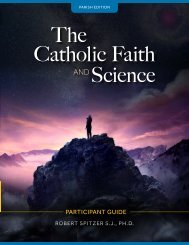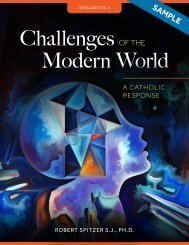Exploring Catholic Social Teaching
Create successful ePaper yourself
Turn your PDF publications into a flip-book with our unique Google optimized e-Paper software.
LESSON PLAN<br />
C. Ask students to connect the needs from the first column with the concrete acts in the second<br />
column (e.g., the need for food; soup kitchen).<br />
D. Transition the conversation toward why we act charitably. Encourage students to connect this<br />
activity to Jesus’ teachings: the greatest commandment, to love one another as He has loved us.<br />
DAY TWO<br />
Warm-Up<br />
A. Ask students to recall “Hunter’s Story” from yesterday’s lesson, then ask whether they think there<br />
was anything mysterious about determining what Hunter needed and how someone could meet<br />
those needs. Students should respond that it was not a difficult process.<br />
B. Tell students how through the gift of our consciences, God has written His law on our hearts.<br />
If we listen to God’s voice in quiet and stillness, He will help us live out His mercy and love each<br />
other as He has loved us.<br />
Activity<br />
A. Distribute and have students complete Handout B: The Corporal and Spiritual Works of Mercy<br />
individually. They should then pair up and discuss their responses.<br />
B. Call on a few students to share their responses with the class, providing correction as needed.<br />
C. Ask again if there are any of the Works of Mercy that are mysterious or hard to figure out?<br />
Aren’t these all what we would want someone to do for us if we needed them to?”<br />
D. Write on the board the Golden Rule that Jesus gives us in Matthew 7:12:<br />
“Do to others whatever you would have them do to you. This is the law and the prophets.”<br />
E. Connect Jesus’ teaching to the Works of Mercy, reminding students that the Church believes<br />
these works to be essential to the Christian life<br />
DAY THREE<br />
Warm-Up<br />
A. Go around the room and have each student draw a slip from the shoe box or container with<br />
the students’ definitions of mercy . Ask them to consider whether the definition fits with the<br />
one they had in mind. Call on a few students to read their definitions aloud and comment on<br />
whether they think the definition is correct and complete.<br />
B. Write on the board the definition of mercy provided in the glossary of the Catechism of the<br />
<strong>Catholic</strong> Church:<br />
Mercy: The loving kindness, compassion, or forbearance shown to one who offends.<br />
EXPLORING CATHOLIC SOCIAL TEACHING, lesson 6 69

















